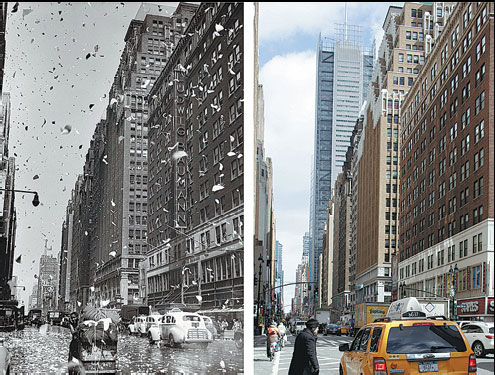Photos capture old New York
|
This combination shows Weegee's 1945 photo, Celebration in the Garment District, on Japan's offer to surrender, provided by the International Center of Photography in New York, and the same vantage point on March 18. Associated Press |
A new book of photos by legendary photographer Weegee shows what industrialized, pre-gentrified New York looked like in the mid-20th century, before the city was crammed with towers and billboards.
Weegee, whose real name was Arthur Fellig, was famous for sensational but artfully composed black-and-white pictures of crime scenes, fires and other urban mayhem. The Weegee Guide to New York includes a few of those tabloid-worthy images of bodies sprawled on the pavement. But most of the book's photos show ordinary neighborhoods and streetscapes with low-rise buildings, bulky cars, empty skies and remarkably uncluttered public spaces.
A 1940 photo of Lower Manhattan, shot at night from across the river near the Brooklyn Bridge, is dominated by a mere three skyscrapers, a shocking contrast to the forest of towers now surrounding 1 World Trade.
A 1946 image shows a fire in a loft building at Fulton and Greenwich streets. The intersection would be unrecognizable to Weegee today: It's the site of the 9/11 Memorial and museum.
A 1952 picture shows the stately, pristine stone facade of One Times Square, where a spire on the roof is still used for the New Year's Eve ball drop. Today the building's exterior is covered with billboards. But Weegee's 1957 view of Times Square does show neon ads, including now-outmoded brands like Admiral TV appliances alongside still-familiar names like Budweiser.
Other photos, lined up with contemporary views of the same spot, are surprisingly unchanged - like a 1939 scene in Little Italy where small shops still line the sidewalks. A 1953 photo shows Humphrey Bogart on the marquee of the Victory movie theater, home now to the New Victory, which specializes in children's entertainment.
The photos in the book are organized by neighborhood, with maps and locations for each, including which direction Weegee was facing when he took the picture. The information makes it easy to compare images with how the city looks today - either by walking around or by going on Google Street View.
"The classic New York skyline has changed dramatically since Weegee's day, and the flurry of often mundane building construction over the last decades has obscured many of New York's iconic skyscrapers," says Philomena Mariani, director of publications at the International Center of Photography, who compiled the book with another ICP staff member, Christopher George.
Mariani says she hopes the book, published by Prestel, will get people thinking not only about "how different the urban landscape is physically," but also about "the public life that existed through the mid-20th century that Weegee captured."
Weegee died in 1968.



















